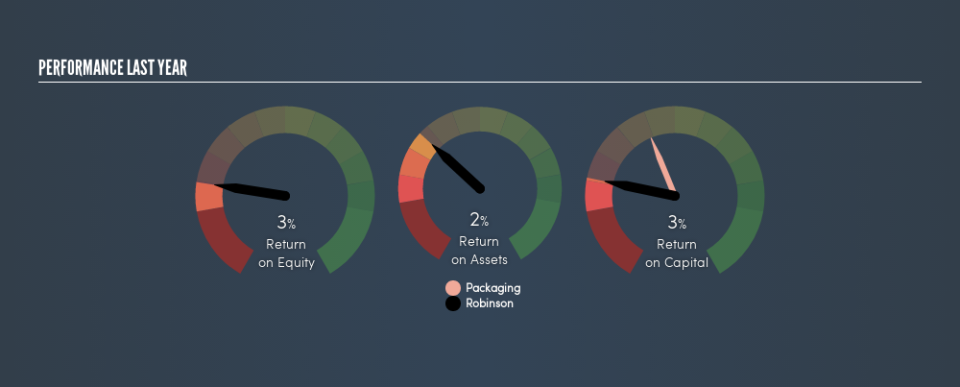Why We’re Not Keen On Robinson plc’s (LON:RBN) 2.6% Return On Capital

Today we'll look at Robinson plc (LON:RBN) and reflect on its potential as an investment. To be precise, we'll consider its Return On Capital Employed (ROCE), as that will inform our view of the quality of the business.
Firstly, we'll go over how we calculate ROCE. Then we'll compare its ROCE to similar companies. And finally, we'll look at how its current liabilities are impacting its ROCE.
What is Return On Capital Employed (ROCE)?
ROCE measures the 'return' (pre-tax profit) a company generates from capital employed in its business. Generally speaking a higher ROCE is better. In brief, it is a useful tool, but it is not without drawbacks. Renowned investment researcher Michael Mauboussin has suggested that a high ROCE can indicate that 'one dollar invested in the company generates value of more than one dollar'.
So, How Do We Calculate ROCE?
The formula for calculating the return on capital employed is:
Return on Capital Employed = Earnings Before Interest and Tax (EBIT) ÷ (Total Assets - Current Liabilities)
Or for Robinson:
0.026 = UK£731k ÷ (UK£40m - UK£12m) (Based on the trailing twelve months to December 2018.)
So, Robinson has an ROCE of 2.6%.
View our latest analysis for Robinson
Is Robinson's ROCE Good?
ROCE can be useful when making comparisons, such as between similar companies. Using our data, Robinson's ROCE appears to be significantly below the 5.3% average in the Packaging industry. This could be seen as a negative, as it suggests some competitors may be employing their capital more efficiently. Putting aside Robinson's performance relative to its industry, its ROCE in absolute terms is poor - considering the risk of owning stocks compared to government bonds. Readers may wish to look for more rewarding investments.
Robinson's current ROCE of 2.6% is lower than its ROCE in the past, which was 9.3%, 3 years ago. Therefore we wonder if the company is facing new headwinds. You can click on the image below to see (in greater detail) how Robinson's past growth compares to other companies.
When considering this metric, keep in mind that it is backwards looking, and not necessarily predictive. ROCE can be deceptive for cyclical businesses, as returns can look incredible in boom times, and terribly low in downturns. ROCE is only a point-in-time measure. Since the future is so important for investors, you should check out our free report on analyst forecasts for Robinson.
How Robinson's Current Liabilities Impact Its ROCE
Current liabilities are short term bills and invoices that need to be paid in 12 months or less. Due to the way the ROCE equation works, having large bills due in the near term can make it look as though a company has less capital employed, and thus a higher ROCE than usual. To counter this, investors can check if a company has high current liabilities relative to total assets.
Robinson has total assets of UK£40m and current liabilities of UK£12m. As a result, its current liabilities are equal to approximately 31% of its total assets. With a medium level of current liabilities boosting the ROCE a little, Robinson's low ROCE is unappealing.
Our Take On Robinson's ROCE
There are likely better investments out there. Of course, you might also be able to find a better stock than Robinson. So you may wish to see this free collection of other companies that have grown earnings strongly.
For those who like to find winning investments this free list of growing companies with recent insider purchasing, could be just the ticket.
We aim to bring you long-term focused research analysis driven by fundamental data. Note that our analysis may not factor in the latest price-sensitive company announcements or qualitative material.
If you spot an error that warrants correction, please contact the editor at editorial-team@simplywallst.com. This article by Simply Wall St is general in nature. It does not constitute a recommendation to buy or sell any stock, and does not take account of your objectives, or your financial situation. Simply Wall St has no position in the stocks mentioned. Thank you for reading.

